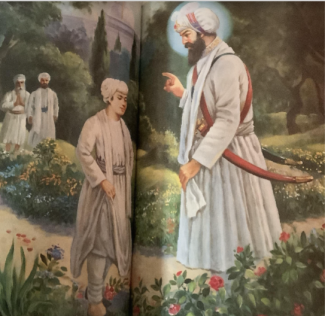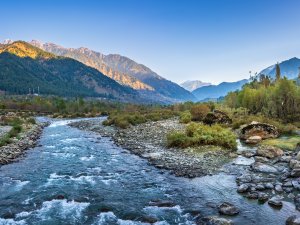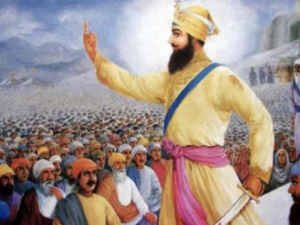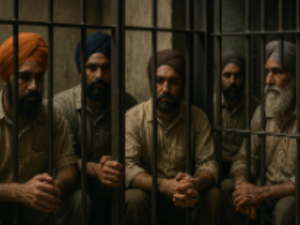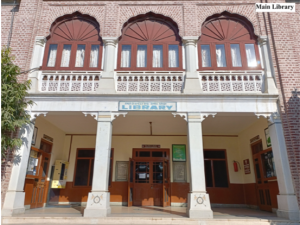Humu Hast Har Rai Karta Guru
Bad Ashkara Hama Pushto Ru. (25)
( Jot Bigas - Bhai Nand Lal )
Meaning Har Rai Karta is the Guru, to whom the true path of everything is clearly revealed.
According to Bhai Nand Lal Goya's other famous Persian poem Ganjnama:
"His seventh kingdom is greater than the seven kingdoms and the nine heavens, and hundreds of thousands of earthly people from the seven sides and the nine boundaries are standing at his door and the holy angels are his obedient servants. He is about to break the snares of death, and the fierce Jamaraj's breast bursts to hear his glory. He is enthroned on the throne of imperishable majesty, and beloved of the bountiful (Nirankar) dargah. He Himself is the bestower of glories and blessings, and His might and power prevail over nature”.
1.BIRTH AND EARLY LIFE
Seventh Nanak Guru Har Rai Sahib was born on Magh Sudi 13 Sammat 1687 Bikrami (i.e. 16 January 1630 CE) in the house of Mata Basi (Mata Ananti, Mata Nihal Kaur) and Guru Hargobind Sahib at Kiratpur Sahib. Kiratpur Sahib falls in the present-day Ropar district of Punjab. Guru Hargobind Sahib had five Sahibzada - Baba Gurditta Ji, Baba Atal Rai Ji, Baba Suraj Mall Ji, Baba Ani Rai Ji and Guru Tegh Bahadur Sahib. Guru Sahib also had a daughter Bibi Veero ji. Baba Gurditta Ji had two sons - Baba Dhir Mall Ji and (Guru) Hari Rai Sahib. Kiratpur Sahib is a city situated on the banks of Sutlej river which is 22 km away from Ropar. This city was founded by Baba Sri Chand (elder son of Guru Nanak) on May 1, 1626 CE.
Guru Har Rai Sahib was a kind-hearted and devoted nature, while he was a great embodiment of power and gentleness. Guru Hargobind Sahib loved his grandson the most and the name 'Har-Rai' was given by Guru Hargobind Sahib himself. (Guru) Har Rai Sahib's early years were spent under the supervision of Guru Hargobind Sahib. (Guru) Har Rai Sahib got his basic education from his family and also became proficient in weaponry. Along with basic education, he studied Guru Granth Sahib and Sikh history. Although Dhir Mall was older than (Guru) Har Rai Sahib, he was not faithful. It was Dhir Mall’s nature to conspire with rhetorical enemies. In those scattered days, (Guru) Har Rai Sahib had proved himself worthy of the leadership of the Sikh community. (Guru) Har Rai Sahib was skilled in horse riding and in handling all kinds of weapons.
(Guru) Har Rai Sahib was only seven years old when Bhai Daya Ram Silhi came to the holy land of Kiratpur from Arup Nagar village in Gujranwala district. He requested to marry his beautiful and talented daughter Sulakhni to (guru) Har Rai Sahib. The owner of Miri-Piri, Guru Hargobind Sahib, Baba Gurditta Ji and Mata Basi Ji accepted the request of Bhai Daya Ram who came from afar and performed the betrothal ceremony. Bhai Daya Ram in 1640 CE. applied to fix the date of marriage. Baba Gurditta passed away in those days. Guru Hargobind Sahib and Mata Basi Ji had to do all the arrangements for the wedding. (Guru) Har Rai Sahib's Barat left from Kiratpur Sahib crossed Sutlej, Beas and Ravi rivers and reached Arup Nagar village in Gujranwala district (now Pakistan). Guru Hargobind Sahib did not participate in this barat, but all the relatives and village residents participated in the barat under the supervision of Baba Ani Rai. Remember, Suraj Mall Ji, (Guru) Teg Bahadur Sahib and Dhirmal Ji etc all participated in this barat. Bhai Daya Ram Silhi greeted the Barat enthusiastically and did a lot of services. These three children of Guru Hari Rai Sahib were very talented and virtuous. The literacy of these three children was approved under the supervision of Dewan Durga Mall. On 5th October 1661, Guru Har Rai ji handed over the responsibilities of Gurgaddhi to (Guru) Harikrishan Sahib and on Sunday 6th October 1661 emerged with the eternal light. (Guru Kyan Sakhiyan, Issue 57)
2.ROYAL DECREE, DARA SHIKOH AND ROYAL THRONE
At the time of Emperor Jahangir, many people had left this mortal world due to fever in Lahore and Kashmir. First Guru Hargobind Sahib came to Kashmir in 1620 and helped the Kashmiris and then Guru Har Rai Sahib in 1660 came to Kashmir and stayed here for about four months and continued to help the poor, the distressed and the afflicted with the tithes of the Sikhs. During the reign of Emperor Shah Jahan, there was a lot of drought and famine in the whole of India. In 1646, Emperor Shah Jahan initiated the digging of canals in Punjab and in 1646, famine struck. Due to three years of hardship and hunger, a mess was built and several langars were also started for the people from the royal treasury. Guru Hari Rai Sahib started langars with the tithe money of the Sikhs to help the famine victims and helped a lot.
On the other hand, the royal order against the temples was passed. Hindu idolatry was at its peak. By the order of Emperor Shah Jahan, all Hindu temples were demolished, and the renovation of old temples was stopped. Hindus were made Muslims by the force of the sword. During the Mughal era, Sirhind, Ambala, Lahore, Thanesar, Ahmedabad, Jaunpur, Kashmir and Burhanpur were considered centers of Islamic propagation.
This royal order was not acceptable to the Sikhs because the Sikhs were not idolaters, they only believed in one 'Akal Purakh'. Akal Takht Sahib and Darbar Sahib Amritsar were built only a few years ago. Many Gurdwaras were also built in Malwa, Majhe and Doaba. It is clear that Shah Jahan's edicts regarding Gurdwaras were not as favorable as those issued regarding Hindu temples. During the Mughal Sultanate, the communication of the intelligence department was very powerful. Emperor Shah Jahan knew that true sympathy for the poor and distressed people in times of trouble.
It was only natural that Guru Sahib had an effect on the king. Dara Shikoh was the eldest son of Emperor Shah Jahan. Although Dara Shikoh was a brilliant man, and he was considered to be a connoisseur of many languages. He had good friendly relations with the followers of many religions. According to Sikh chronicles, Dara Shikoh had a close friendship with Guru Har Rai Sahib as mentioned by Zulfikar Ardastani in the Persian source 'Dabistan-Mazahib'. Dara Shikoh was also the governor of Allahabad, Gujarat, Multan, Punjab and Kabul. On 3 February 1655, he was given the title of 'Shah-e-Buland Iqbal' and was also presented with a golden throne. When Emperor Shah Jahan fell ill in September 1657, he (Shah Jahan) nominated his eldest son Dara Shikoh as his successor. . When this news reached Aurangzeb, he rebelled against his father and brother Dara Shikoh with a large army. The battle took place on 29 May 1657 at the location of Shamu Garh near Agra. In this battle, Aurangzeb defeated the forces of his father Shah Jahan and brother Dara Shikoh. Aurangzeb ascended the throne on 21 July 1658. Defeated, Dara Shikoh fled to Punjab territory. Aurangzeb's army under the command of Mirza Jai Singh Ambri followed him. Guru Hari Rai Sahib was in Goindwal when Dara Shikoh approached the river Beas. According to the 'Mahima Prakash' source, when Dara Shikoh reached Goindwal, he requested Guru Har Rai Sahib for help. With the timely help of Guru Sahib, Dara Shikoh escaped from Punjab safely.
Guru Har Rai Sahib sent his cavalry to the banks of the Beas by which, taking the boats under their authority, they prevented Aurangzeb's army under the command of Raja Jai Singh from crossing the river for a day or two. Dara Shikoh sent off with 'Guru Ka Langar'. Dara Shikoh remained loyal to Guru Sahib till the end of his life in return for this philanthropic work.Dara Shikoh finally left for Lahore. He reached there collected an army of 20,000 but then fled to Multan on 18 August 1657. After Multan, he was finally caught after wandering here and there in Sindh, Gujarat and Balochistan. He was arrested in Daura Bolan' Balochistan due to the treachery of his personal confidant Jeevan Mall in his extradition. By the order of Arangzeb, he was brought to Delhi and his (Dara Shikoh) head was severed from the torso. This incident is on the night of 30-31 August 1639.
3. BABA RAM RAI’S DEPARTURE FOR DELHI
As soon as Aurangzeb sat on the throne of Delhi, he sat down to punish his enemies. Anyone who had helped Dara Shikoh in the slightest was summoned to Delhi. Such honors also reached Guru Har Rai Sahib. Raja Jai Singh's Diwan Paras Ram reached Kiratpur Sahib on 29 March 1661 with Aurangzeb's summons. It was only a few months since Guru Sahib came from Jammu and Kashmir.
Guru Har Rai Sahib sent his elder son Ram Rai with Paras Ram Diwan to Delhi. Along with Ram Rai ji, Dewan Dargah Mall, Bhai Dariya and Bhai Gurdas (son of Bhai Bahlo) accompanied him. On reaching Delhi, Baba Ram Rai met Aurangzeb and performed many miracles to please the emperor. According to Guru Kyan Sakhis, Sri Guru Pratap Suraj Granth and Tawarikh Guru Khalsa, Baba Ram Rai greatly impressed Aurangzeb through his erudition, attendance and miracles and performed 72 miracles in Delhi. Special among them were driving a chariot without horses, sitting comfortably on a sheet spread on a well, not being affected by poisoned clothes, walking on the water of the Jamna River, riding a drunken elephant, driving a palanquin without wheels, etc. ('Khalsa Nama”). Bakht Mull gives another reason for summoning Guru Sahib that the king wanted to see Guru Ji performing miracles. Aurangzeb wanted to reassure that there is nothing against Islam in the Sikh religion? The king asked many questions to Baba Ram Rai ji. One of the questions was:
ਮਿਟੀ ਮੁਸਲਮਾਨ ਕੀ ਪੇੜੈ ਪਈ ਕੁਮ੍ਹਿਆਰ ॥
ਘੜਿ ਭਾਂਡੇ ਇਟਾ ਕੀਆ ਜਲਦੀ ਕਰੇ ਪੁਕਾਰ ॥
ਜਲਿ ਜਲਿ ਹੋਵੈ ਬਪੁੜੀ ਝੜਿ ਝੜਿ ਪਵਹਿ ਅੰਗਿਆਰ ॥
ਨਾਨਕ ਜਿਨਿ ਕਰਤੈ ਕਾਰਣੁ ਕੀਆ ਸੋ ਜਾਣੈ ਕਰਤਾਰੁ ॥੨॥
Miti musalman kī perai pa ī kumĥipār.
Ghar bhände ita ki-ā jaldi kare pukar
Jal jal rovai bapuri jhar jhar pavėh angi ār.
Nanak jin kartai karan ki a so janai kartār.
The clay of the Muslim's grave becomes clay for the potter's wheel.
Pots and bricks are fashioned from it, and it cries out as it burns.
The poor clay burns, burns and weeps, as the fiery coals fall upon it.
||2|| O Nanak, the Creator created the creation; the Creator Lord alone knows.
Aurangzeb asked Ram Rai that why Muslims have been condemned in this way in Guru Granth Sahib? Baba Ram Rai made an opportunity by changing a word in this verse of Gurbani. He said: The word 'Muslim' has been written by a writer's mistake; the original word is 'Beiman'. The king was pleased and gave Jagir to Baba Ram Rai in the valley of Doon (Dehradun). (Khalsa Nama, Bakht Mall, page 10) Dehradun, remember, is the headquarters of Ram Rai's Dehra, which Ram Rai founded. His followers are called 'Ramarai'. On the order of Guru Gobind Singh, the Amritdhari Sikhs have been boycotting him socially.
Guru Har Rai Sahib was very saddened to hear the news of the lack of truth and courage in his eldest son. Guru Sahib declared Ram Rai ineligible for the post of Gurgaddi. Guru Sahib sent a message to Delhi that he should not show his face. Guru Sahib sent an edict to the Sikh Sangat that they should not face Ram Rai. It is mentioned in history that even though Ram Rai came later and apologized to Guru Sahib, Guru Sahib deprived him of the throne. Ram Rai stayed at Kiratpur Sahib for some time and later went to Delhi with Emperor Aurangzeb. When Ram Rai was still in Delhi, Guru Har Rai Sahib gave Gurgaddi to (Guru) Harikrishan Sahib and on 6th October 1661 he emerged with eternal light.
4. BLESSINGS AND PREACHING CENTRES
It is mentioned in the Sikh chronicles that Guru Nanak Sahib's elder son Baba Sri Chand ji started the Udasi sect. Guru Har Rai Sahib's father Baba Gurditta Ji became his first disciple. There were four famous sewaks of Baba Gurditta who laid the foundation of the four dhunas. Apart from the four dhunas, six gifts are also famous in Sikh history. The heads of these bounties have also become Udasi Sadhus like Dhoonas. They used to preach and spread Gurmat in far and scattered areas. According to the author of 'Gurshabd Ratnakar Mahankosh', Guru Har Rai Sahib had three gifts:
a.Suthra Shahi-Bakhshish. Guru Har Rai Sahib.
b. Sangat Sahibiye-Bakhshish Guru Hari Rai and Guru Gobind Singh Sahib.
c. Bhagat Bhagwaniye-Bakhshish. Guru Hari Rai Sahib
Apart from these Bakhshish, Jita Malliye and Bakht Malliye Bakhshish Guru Gobind Singh Sahib and Meehan Sahibiya Bakhshish Guru Teg Bahadur Sahib are famous.
a .Bakshish Suthra Shahi:
The head of this center was Bhai Suthra Shah. According to Sikh history, Bhai Suthra Shah had a tooth in his mouth and a black mark on his forehead at the time of his birth. His parents threw him in the forest at the behest of a Brahmin. When Guru Hargobind Sahib passed by while hunting near Singhpura forests, he took Suthra Shah out of the forest and named him Suthra Shah.Bhai Suthra Shah was born in 1615 CE in the house of Nanda Khetri in Berhampur, which is a village in Baramulla (Kashmir). Bhai Suthra Shah's childhood grew up under the care of Guru Hargobind Sahib and this starist poet later became famous.His disciples Hare Shah, Bahadur Shah, Sangat Sahib, Brahm Shah etc. are particularly notable.
b .Sangat Sahibiye Bakhshish
Sangat Sahibiye Bakhshish started during the time of Guru Har Rai Sahib. Bhai Sangat (Bhai Feru or Sangat Sahib) was born in village Daroli (District Ferozepur) in 1640. Bhai Sangat Ji in 1656 joined the service of Guru Hari Rai Sahib. Pleased with his tireless service, Guru Har Rai Sahib sent him to Lahore with a Nagara and Dastar where he started preaching 1701 CE only by focusing on Bhai Pheru's Gursikhi preaching activities. On the day of Baisakhi, Guru Gobind Singh Sahib blessed again. This gift is also called 'Sangat Sahibiye' or 'Sangat Sahib '. It was sent by Guru Sahib for preaching to the east where it established many preaching centers. He died in 1706. Many Udasi sadhus related to this sect became famous, among which Charan Das, Bridaban, Khaneshah Das, Chukha Das etc. Sadhus are worth mentioning, who served the preaching.
c . Bhakta Bhagwaniye Bakhshish:
Bhagat Bhagwan whose real name was Bhagwan Gir and who was a Brahmin Sadhu of Bodh Gaya (Bihar). He had already heard the glories of Guru Nanak Sahib's house. Once Kiratpur Sahib came to meet Guru Har Rai Sahib sitting on the throne of Guru Nanak Sahib. He joined the Sikh religion along with his companions after visiting Guru Sahib. They used to do this preaching all the time and the number of sadhus associated with this sect is very large.
Guru Sahib gave the responsibilities of Bihar, Bengal and Assam to Bhagat Bhagavan. He diligently propagated Sikhism in far-flung areas, eastern regions and established preaching centers. His followers are called 'Bhagat Bhagwaniye'. Tikka Ram has been a great propagator of this sect. From Bihar to Sindh, their preaching centers flourished well. Bhagat Bhagwan was a contemporary of Guru Har Rai Sahib but not much research has come out about his early life.
With the passage of time, these Udasi Sadhus moved away from Gurmat and now consider themselves to be a completely different sect from Sikhism. Today, there is an urgent need to re-incorporate this part of the panth into the panthic circles with an understanding of the glorious history.
5. SELECTED STORIES OF THE TIMES:
There are many sakhis from the life of Guru Har Rai Sahib in which the teachings of Sikhism are witnessed. Even though there is no 'Bani' of Guru Sahib, there are many sakhis in his life. But here we will mention only a few selected sakhis.
- Love for flowers and plants:
Guru Har Rai Sahib's love for flowers and plants was deep and intense. Once Guru Sahib was walking in his garden in Kartarpur (Jalandhar) when some flowers fell down on his open robe. The fall of beautiful flowers became unbearable for Guru Sahib. It is remembered that Guru Sahib used to wear a garment with as many as one hundred buds. When Guru Hargobind Sahib saw it, he instructed: "Brother, if we wear this big garment, then we should wrap it up and walk." From that day on, he always started walking with his clothes wrapped around him. This wise admonition became an integral part of Guru Sahib's life.
- Introduction of Dispensary:
Guru Har Rai Sahib also started a big dispensary. They used to treat many diseases by giving medicines to the poor and sick. Guru Sahib thus made a special arrangement for the public welfare works of health and enlightenment. Guru Sahib himself used to grow many herbs in his garden and used to bring precious and rare medicines from far away and keep them in his dispensary.Once Dara Shikoh, the son of Emperor Shah Jahan, provided a certain weight of saffron and cloves recommended by renowned healers for severe illness and also gave a medicinal substance 'Jagmati' for greater effect. Dara Shikoh got cured within a few days and came to the Guru's house to pay his gratitude to Guru Sahib and had darshan-dedar. There was a lot of chatter. The popularity of this pharmacy was spread far and wide.
- Zoo:
Guru Har Rai Sahib also continued the practice of hunting following the footsteps of his grandfather Guru Hargobind Sahib, but Guru Sahib's approach was surprisingly successful. Guru Har Rai Sahib always kept 2200 cavalry with him so that he could be used as per need and time. Guru Sahib kept roaring all the time from bloodshed. When Guru Har Rai Sahib went on a hunting expedition with the Singhs, during the hunting he would catch many birds and animals alive and keep them in the zoo built in his garden. Every day these birds and animals are given grass, bait etc. In this way, with love and care, they would manage their protection. Guru Sahib had this strange hobby.
- A Poor Woman of Malwa:
Once a poor woman of Malwa came to visit Guru Har Rai Sahib with the Sangat of her locality. This Mai cooked some bread and brought a Khadar chadar for Guru Sahib. Seeing the glory of the court, she kept standing far from Guru Sahib thinking that Guru Sahib would accept my bread and chadar. Guru Har Rai Sahib went to the side where Mai was standing while taking a walk. Guru Sahib himself asked for both things.
- Respect for Gurbani:
One day Guru Har Rai Sahib was lying on the bed at night. A group was coming to perform Shabad-Kirtan for darshans. When Guru Sahib heard the word, he immediately got off the bed and sat down. Due to which the knee also got hurt. Since that day, Guru Sahib never lay on the bed because this way the word is disrespected.
- Bestowing the boon of the kingdom:
Once Guru Sahib reached the village of Mamar where Chaudhary Kala brought his two nephews with him namely Sundhali and Phul. Guru Sahib blessed these orphans that their progeny would rule. Their descendants ruled in Nabha, Patiala and Jind.
6. TRAVELS
Guru Har Rai Sahib traveled to far-off and harsh areas for the propagation and spread of Sikhism. Guru Sahib first preached in the surrounding villages of Kiratpur Sahib and later he actively made preaching tours in Doaba, Malwa, Majha, Kurukshetra, Kashmir and Jammu etc.
This journey was for the propagation of Sikhism from 1654 to 1660 CE. Until Guru Sahib did. It is mentioned in the Sikh history that Guru Sahib divided the Sikh Panth into 360 parts to strengthen it organizationally, each part under the supervision of a chief Sikh. With this tithe, the organizational structure became better, and the relationship of the Sikhs with Guru Sahib was also better. While Guru Sahib's preaching tours were going up and down towards Punjab, they were also going towards Jammu and Kashmir.
According to Professor Sahib Singh, Guru Har Rai Sahib traveled for four years from 1654 to 1658 in the area of Doaba, Malwa and Majha. Starting from Kiratpur Sahib, Guru Sahib also went outside the city of Kartarpur while staying in the villages of Badi Bahli, Harian Velan, Bhugrani, Bombeli etc. Guru Sahib stayed here for fifteen days and went to Amritsar where he stayed for six months. After this Guru Sahib went to Kartarpur where he stayed for ten months. It was here that Bhai Bhagat, the famous preacher of Malwa, visited Guru Sahib and after his death, Guru Sahib appointed Bhai Bhaktu's younger brother Jeune as Masand of Malwa in place of Bhai Bhaktu. Starting from Kartarpur, Guru Sahib reached the village of Maharaj passing through Nurmahal, Droli, Bhai Rupa, Kangar etc. Chaudhary Kale from here served Guru Sahib wholeheartedly. Guru Sahib stayed here for many days. One day Chaudhary Kala brought his two nephews Fool and Sundhali to Guru Sahib. The children's parents were dead, and Chaudhary Kala was the only one who looked after them. The children bowed before Guru Sahib and started clapping their hands on their bellies. Guru Har Rai Sahib laughed seeing this. Guru Har Rai Sahib promised that his descendants would rule between Sutlej and Jamuna. The next day Chaudhary Kala taught his children and brought them to Guru Sahib's court on the request of his wife. Guru Sahib promised that their progeny will also be forgiving.
Guru Hari Rai Sahib stayed in Kiratpur Sahib for three months while visiting Ras Biju Ke, Jandan Wal and other villages. According to Sahib Singh, Guru Har Rai Sahib stayed at Kartarpur for five months and then went to Majha and stayed at Goindwal Sahib for a few days and then returned to Kiratpur Sahib by crossing the Sutlej. This whole cycle was about four years.The villages where Guru Har Rai Sahib went for preaching in Punjab are incorporated at the end. Guru Sahib stayed in Jalalpur Jattan village from July to October 1659. Guru Sahib used to decorate a Diwan daily and bless the Sangat with Gurbani. Guru Sahib stayed with Bhai Sabla Masand in Jalalpur Jattan. Bhai Sabla (Masand), his wife Bibi Sama and sons Bakhtamal served the Guru Sahib and the Sikhs wholeheartedly. Guru Sahib stayed in this village during the rainy season. From Jalalpur Jattan village, Bhai Padma Chauhan took to his village Daburji (Sialkot district). For some days, Guru Sahib preached religion in this village. It was here that Bhai Kirtia took Guru Sahib to his home in Galotian Khurd (Tehsil Daska, District Sialkot). Guru Sahib stayed with Bhai Kirtia from December to February 1660 i.e. winter season. Guru Sahib stayed in Khurd and converted many into Sikhism. From March 28 to mid-April 1660, Guru Sahib stayed in the city of Sialkot. Here Guru Sahib's Bhai Nand Lal Puri (Grandfather of Vir Haqiqat Rai Shaheed) and his wife, two children Bhai Bhag Mall and Bagh Mall served wholeheartedly. Guru Sahib had told Nand Lal Puri while giving the gift of Sikhism, not to cut kes(hair) , not to wear a hat and not to use tobacco.
In mid-April 1660, Bhai Makhan Shah Vanjara also came to Sialkot city with his Tande. He requested Guru Sahib to give darshan to the Sikh Sangat of Srinagar (Kashmir). The Guru Sahib accepted his request and proceeded to Srinagar with him. Guru Har Rai Sahib's visit to Kashmir is also mentioned in Bhat Wahi Talaundha, Pargana.
On reaching Srinagar, Guru Har Rai Sahib was warmly welcomed by the Sikh Sangats and especially by Bhai Dasa (father Makhan Shah), Bhai Aru Ram (Father Bhai Kirpa Ram), Bhai Madho Das Sodhi, Bhai Sevadas and Bhai Ramgarhia. Guru Har Rai Sahib went to the surrounding areas of Srinagar and then went to Mattan Sahib where Guru Nanak had first set his blessed feet. Guru Sahib stayed in Kashmir for four months. Remember that Guru Sahib reached Kashmir on 20 April 1660.Guru Sahib preached a lot in Kashmir. For a long time in Srinagar, Guru ji stayed with a low caste Brahmin near Hari Parbat.
Bhai Sewa Das, Bhai Madho Sodhi, Bhai Ramgarhian etc. Gursikhs used to live near here. Next to Hari Parbat, where Guru Sahib stayed, later 'Chae Guru Har Rai Gurdwara' was built. This place was earlier called Satguru Devi Angan, Haq Bazar. Further details of this Gurdwara are found in the Persian manuscript Dastur-al-Amla (misleadingly called Tarikh Kalan). During the Sikh rule, the granthi of this Gurdwara was Diwan Singh. During the Sikh rule, this historical place had a jagir of 248 kanals of land. It was here that Guru Sahib dug this well, due to which the Gurdwara was called Chai Guru Hari Rai Sahib. This Gurdwara has disappeared due to the neglect of the Kashmiri Sikhs. Guru Sahib was still in Srinagar when the news reached that Bhai Dasa, the father of Makhan Shah Vanjare, had passed away. Guru Sahib went to his village Mota Tande. Guru Sahib stayed here for a few days and proceeded towards Akhnoor. Guru Har Rai Sahib left for Akhnoor in the third week of August 1660. Guru Sahib reached the city of Jammu giving sermons to the Sangats after taking the mountain route. Bhai Kanha and Sikh Sangat visited Guru Sahib in Jammu. Starting from Jammu, Guru Sahib reached Pathankot via Ramgarh, Khirdi, Samba. Here Guru Sahib camped on a high hill. Where he removed the suffering of a poor mother's son. Guru Sahib stayed in Pathankot for two days and continued to bless the Sangat with Gurbani. From here Guru Sahib proceeded towards Kiratpur Sahib and continuously engaged in preaching for six years.
7. MATCHLESS SEVAKS
Guru Har Rai Sahib had hundreds of matchless sewaks who were the owners of many praises. These were Bhai Jiwan, Bhai Bhagtu, Bhai Gohra, Bhai Bhagat Bhagwan, Bhai Pheru, Bhai Jhandha, Bhai Choor Sekhon, Bhai Kirtiya, Bhai Sewa Das, Bhai Garhia, Bhai Sablha, Bhai Nand Lal Puri, Bhai Punger, Bhai Kana, Bhai Goinda, Bhai Mehar Chand Suniara, Bhai Makhan Shah Wanjara, Bhai Behlon, Bhai Phonder, Bhai Punjab etc.
8. GURDWARAS, SHRINES AND MONUMENTS :
Guru Har Rai Sahib went to many towns for the propagation of Sikhism and encouraged the construction of Gurdwaras etc. to improve the economic condition of the people. The Sikhs of Guru have built many Gurdwaras and shrines in towns and villages. These are Amargarh, Amritsar, Sialkot, Sidhwan, Srinagar, Hakimpur, Hadhiabad, HarRai pur, Kartarpur, Kiratpur Sahib, Kotla Nihang Khan, Ghal, Glotian Khurd, Gur Palah, Govindwal Sahib, Khuran, Charnoli, Chonteji, Chandpur, Jaspal Bhaike, Chandha Sahib, Thali Sahib, Dagroo Droli Bhai, Thanser, Dosaj Khurd, Dholewal, Noor Mahal, Pehowa, Phalie, Powadhra, Phagwara, Fateh Pur, Fateh Pur Singhan, Farala, Bassi, Bajroor, Barota Sahib, Bath, Bamelli, Bhai Rupa, Bhungrani, Mehraj, Mattan Sahib, Raipur-Rasulpur, Lehli Kalan and Lombey.
In the end, I would like to conclude the words of Bhai Nand Lal Goya:
Haq Parvar Haq Kesh Guru Karta Har Rai
Sultan Hum Darvesh Guru Karta Har Rai.87
Faizal Drain Guru Karta Har Rai
Sarvari Konan Guru Karta Hari Rai.88
Haq Wasfi Akram Guru Karta Har Rai
Khasan Hama Bar Kam Guru Karta Hari Rai. 89.
Shahnshah Haq Nasak Guru Karta Hari Rai
Firma-dihe nahu tabak Guru Karta Hari Rai.90.
Gardan-Jani Sarkshan Guru Karta Har Rai
Yari Mutzraan Guru Karta Har Rai 91. (Gangnama)
(Guru Karta Har Rai is also the guardian of truth and the bearer of truth, Guru Karta Har Rai is also Sultan and also Dervish. Guru Karta Har Rai is the bestower of both worlds, Guru Karta Har Rai is the lord of both worlds. God is the praiser of the bounties of Guru Karta Har Rai, all special people are successful because of Guru Karta Har Rai. Bani of Guru Karta Har Rai is the king of truth, Guru Karta Har Rai is the one who commands the nine levels (heavens). Guru Karta Har Rai is the be-header of rebels and lone souls, Guru Karta Har Rai is the friend and support of the weak and helpless.)
Dara Shikoh Cured
Tread with Care


